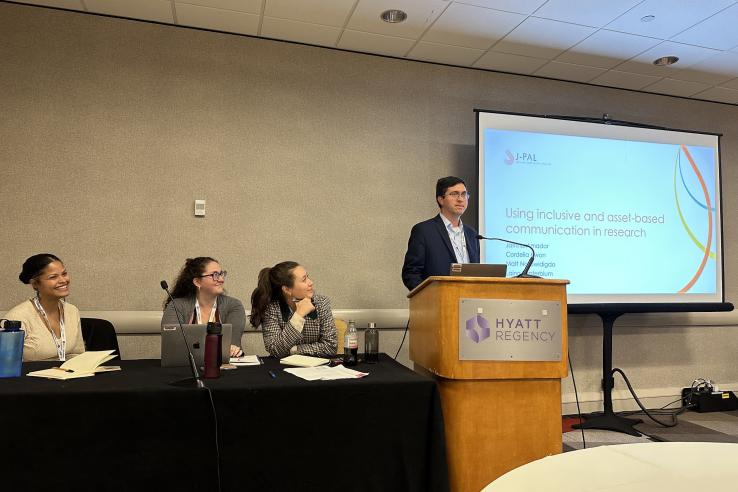
Researching racial equity: Integrating inclusive and asset-based communication throughout the research cycle

In J-PAL North America’s researching racial equity blog series, we discuss how research plays a critical role in identifying structural inequities in systems and policies that disproportionately affect communities of color. In part five, we recapitulate our workshop on inclusive and asset-based communication in research, recently delivered at the Association for Public Policy Analysis and Management’s (APPAM) 2023 annual conference.
The theme for this year’s APPAM conference was “Policy that matters: Making public services work for all.” At J-PAL North America, we believe one critical way to inform policy that matters is by communicating about research in an inclusive and asset-based manner. As such, our staff and Co-Scientific Director Matt Notowidigdo facilitated a workshop on principles of inclusive and asset-based communication and considerations for imbedding these principles throughout the research cycle.
Principles of inclusive and asset-based communication and their value in research
Inclusive and asset-based communication aims to convey both an understanding of and an appreciation for the experiences of all people by a) centering people’s strengths and humanity and b) situating individuals in their larger socio-political contexts. It consists of both inclusive language and asset-based framing. Inclusive language refers to the active process of making intentional choices about language, including what we say (i.e., words) and how we say it (i.e., syntax). J-PAL’s inclusive language principles are described in this blog post.
Asset-based framing refers to centering peoples’ strengths and aspirations before exploring their needs (i.e., deficits). This concept calls on researchers to understand peoples’ full range of experiences and to position those experiences within a larger context. We identify three major principles of asset-based framing:
- Positionality is where one is situated in society based on their identities. Researchers may be familiar with how positionality can influence informed consent if participants feel compelled to comply with what an “expert” is asking. In contrast, some communities may be wary of researchers conducting an evaluation if the researchers do not share common characteristics (e.g., race, socioeconomic status) and experiences (e.g., systemic racial oppression).
- Power dynamics are the formal and informal ways that power is distributed and decisions are made within a society. This principle is closely tied to positionality because where one is positioned in society can impact their perceived power. Decisions about research questions and methodologies are often made among researchers—potentially with input from program administrators—but program recipients are rarely involved. What wisdom and knowledge are missed when these important stakeholders are not included in decision making? A toolkit from Chicago Beyond explores this principle further.
- Historical context refers to socioeconomic and political conditions at a certain time and place, including the present. A number of economic studies ask what interventions can alter the choices people make without accounting for the larger structural contexts that may expand or restrict peoples’ choices. J-PAL affiliated professor Peter Christensen (University of Illinois, Urbana-Champaign) and his co-authors demonstrated effective consideration of historical context in a recent study investigating whether racial discrimination constrains the housing choices people can make.
Inclusive and asset-based communication can enhance research in several ways. First, it can bolster the research and research teams’ credibility among participants and other stakeholders by signaling that researchers respect their humanity and are aware of their context. Most people don’t hold their areas of improvement as key to their identities. Why then would we identify study participants solely by their needs and challenges? Understanding peoples’ experiences holistically—including their strengths—is imperative for forming strong relationships.
Second, they can enhance the accuracy of research results. For example, being specific by describing a primarily Black study population as “primarily Black” may be more accurate than describing the same participants using the umbrella term “people of color,” which could also lead to feelings of erasure. Additionally, situating findings within larger contexts may improve our understanding of underlying mechanisms: outcomes may be due to individual behaviors, but are likely also due to systems and societal constraints (as demonstrated in Peter’s aforementioned study).
Finally, inclusive and asset-based communication can increase a study’s policy relevance by asking human-centered, context-relevant research questions. Working with directly-impacted communities to develop research questions—as demonstrated by J-PAL affiliated professor Marcella Alsan’s (Harvard) racial concordance study—helps ensure that studies are pertinent to participants.
Embedding inclusive and asset-based communication principles into research:
Embedding these principles at each stage of the research process can maximize their impacts. Click the following drop-downs for additional considerations and resources for integrating these principles throughout the research cycle.
Developing a research question
It can feel challenging to frame a research question around assets when theories of change are generally designed to address needs. Asset-based framing does not ignore needs; it merely positions them alongside strengths and within a larger context. Some additional considerations when developing research questions in an inclusive and asset-based manner include:
- Framing questions to investigate how different communities experience economic disparities as a consequence of historic policy choices, rather than how to change peoples’ behaviors in a vacuum. For example, rather than asking “why don’t Black students take AP courses?”, J-PAL affiliated professor Dania Francis (UMass Boston) and her co-authors asked “What exogenous factors influence Black students’ decision to enroll in AP math?” The latter question took the onus off students themselves, subverted racial stereotypes, and enabled the researchers to look at institutional—rather than individual—factors like racialized tracking that may aid or constrain Black students’ academic choices.
- Engaging with directly-impacted communities to incorporate diverse perspectives and lived experiences. (Note that engaging in this work well requires an understanding of power and positionality. It may be useful to engage in a social identity mapping exercise.)
- Collaborating with community organizations to develop theories of change, research questions, and hypotheses. Community members may also offer valuable input into outcomes metrics and the intervention itself, as demonstrated in the Trust Youth Initiative.
Conducting research
Whether or not a research question is asset-based, the methods and tools used to answer that question can encompass inclusive and asset-based communication principles. Some places to consider integrating these principles include:
- Powering and preregistering a study to account for different effects across groups of people. Some programs, for instance, have different impacts on men and women, but these effects can be masked if the sample size is too small to detect them. Before analyzing outcomes across different groups, it is essential to theorize why there might be differences in outcomes across demographic groups. Considering these mechanisms proactively can help avoid reductive conclusions at later stages in the study (e.g., “women experienced the program differently because they are women”).
- Considering stratified (or blocked) randomization, where randomization is done within pre-defined groups of participants. This can ensure equal representation of a group across treatment and comparison groups, enabling effects within these groups to be more precisely estimated. Researchers commonly stratify on characteristics such as race, gender, and employment status.
- Using inclusive surveys and metrics that capture a range of identities. For example, it may be helpful to evaluate whether assessments of gender encompass a range of gender identities or reduce gender to a binary, which may be isolating to respondents and could demonstrate an incomplete understanding of gender.
- Incorporating qualitative data to convey the lived experiences of those impacted by the research.
Analyzing, interpreting, and writing up research results
Regardless of how inclusive and asset-based one’s research questions and evaluation methods are, there may be additional opportunities to utilize inclusive and asset-based communication principles when analyzing and interpreting data. Examples include
- Disaggregating impacts by identities (e.g., race or gender) to understand how outcomes may differ between groups. (Please see note in the “Conducting research” section about disaggregating data with intentionality.)
- Engaging key stakeholders for support with interpreting data, such as by conducting data walks.
- Weaving together qualitative and quantitative results to add nuance and construct a holistic picture of outcomes. For example, the team behind Baby’s First Years used quantitative data to understand how mothers spent their monthly cash gifts and qualitative data to learn why they made those purchases.
A common challenge to using inclusive and asset-based communication when writing up research results is doing so while being concise. For example, “people experiencing homelessness” is both more inclusive and more verbose than “the homeless.” At J-PAL North America, we believe that the benefits of being person-centered merit the extra word count.
Communicating externally about results
A major component of our work at J-PAL North America is disseminating study results to key audiences. This often requires us to “translate” academic materials into non-technical language to be inclusive of our audience while remaining true to the source material. This balance is always a challenge, but the following considerations may be helpful to others engaging in this effort:
- Thoughtfully determining which data to highlight and how to frame it for different audiences (e.g., policymakers, researchers, community members). Being inclusive of audiences by tailoring dissemination to their interests and communication styles may also increase their receptiveness to the material.
- Engaging in open dialogues with communities and partner organizations to share findings through open forums rather than (or in addition to) one-way presentations.
Grounding evidence in inclusive and asset-based communication helps ensure that policies are representative of and responsive to the communities they aim to serve. J-PAL North America’s principles may be a helpful starting point, but these are a work in progress. We welcome and appreciate any feedback. If you would like to discuss these principles or how to embed them throughout the research process, please contact Senior Research Manager Noreen Giga.
The researching racial equity blog series features the contributions of researchers and partners in examining and addressing racial inequities and offers resources and tools for further learning. Part one shares an example of evaluating racial discrimination in employment. Part two features work quantifying housing discrimination. Part three gives an overview of stratification economics in the context of evaluations. Part four discusses how to center lived experiences throughout the research process and in impact evaluations. Part six examines sources of bias in administrative data bias. Lastly, in part seven, Damon Jones and J-PAL staff share progress on researching racial equity and future areas of work.



